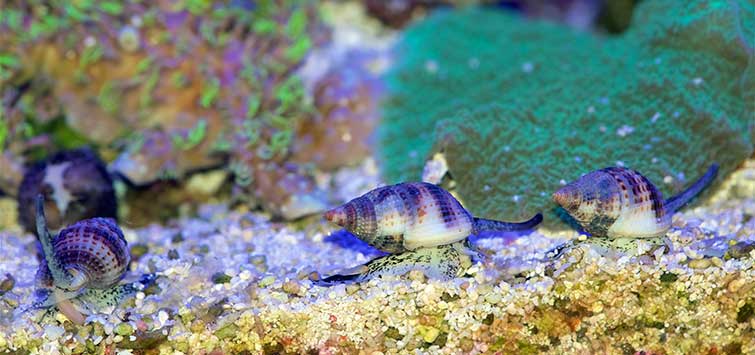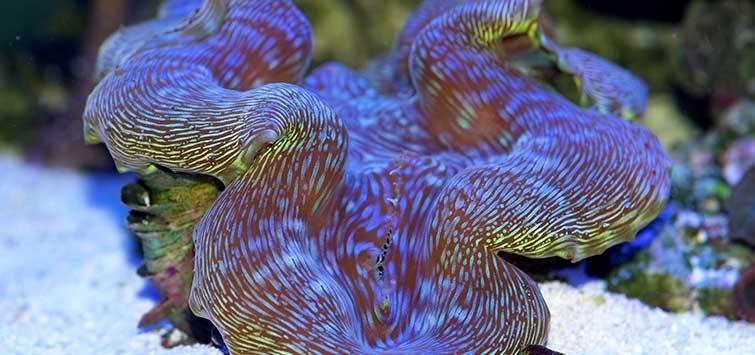6 Creatures for Your Reef Tank Clean-Up Crew
Author: James W. Fatherree
No matter what you do, unwanted algae will grow in a reef aquarium, and it can get out of hand if it isn’t dealt with. It would be nice if there was a way to prevent this from happening in the first place, but there really isn’t. So, we just have to focus on keeping algae growth to a minimum by keeping waterborne nutrients low, manually cleaning it up, and using various herbivores that will eat it.
Quite a few herbivorous fishes will help out, but let’s have a look at some herbivorous invertebrate critters that help to keep a reef aquarium clean without harming fishes, corals, and other animals. They will feed on the fine microalgae coating on rocks, glass, and everything else, and some will also eat the large macroalgae that most often appears as filamentous “hair” algae.
In addition to undesired algae, detritus—the particulate matter composed of feces, uneaten food, mucus from corals, and such—can also accumulate in aquariums, primarily in sandy substrates. However, some invertebrates will dine on this stuff, too, or at least liberate it from the substrate and help to keep a sand bed cleaner.
Together, the backboneless algae- and detritus-eating animals we’ll discuss here can make up a good reef tank clean-up crew.
Snails
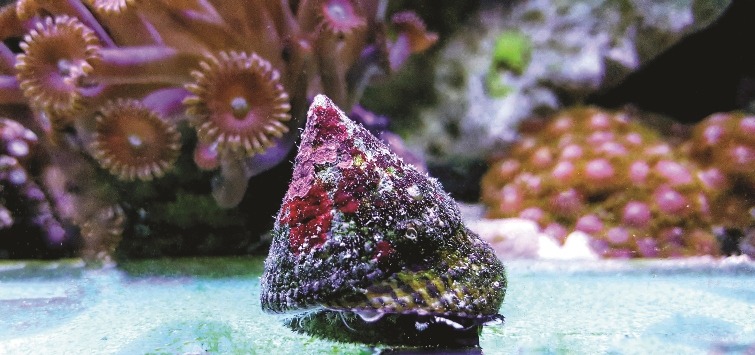
Trochus sp.
Herbivorous snails are the most popular choices for helping to control unwanted algae. Some spend most of their time buried in sediments, some are strictly scavengers, some are carnivores, and many can get far too large to be kept in any typical reef aquarium. However, several herbivore-only species are readily available to hobbyists, with most of them belonging to the genera Astraea, Turbo, or Trochus.
All of these are great cleaners that stay out of trouble and work 24 hours a day, every day, and they typically have full sizes of only 1 to 2 inches (2.5 to 5 cm).
They feed primarily on microalgal films that develop on the rocks and glass, leaving little zig-zag-shaped tracks wherever they go. For over 25 years, I’ve kept a mix of these in every reef aquarium I’ve cared for.
For sure I include the astraea snail, Astraea tecta, which is typically the smallest of the bunch, and the Mexican turbo snail, Turbo fluctuosus, which feeds on any filamentous algae that shows up, too.
Hermit Crabs
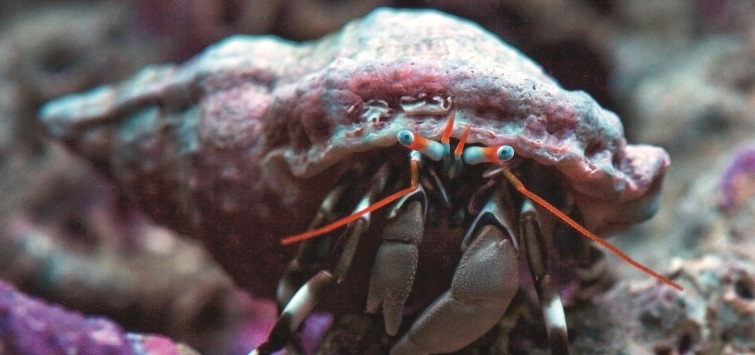
The blue-knuckle hermit crab (Calcinus laevimanus).
Herbivorous hermit crabs come in second place when it comes to aquarium clean-up crew popularity, as a few species are ubiquitous in the hobby and can be great additions to reef tanks. It’s true that some hermits are aggressive carnivores, and many get far too large to keep in a typical reef tank, because they are prone to knocking stuff over and crawling all over corals and such. However, there are a few species that are algae eaters and opportunistic scavengers that stay relatively small in size.
The best species for the job are the blue-leg hermit crab (Clibanarius tricolor), the scarlet hermit crab (Paguristes cadenati), the red-leg hermit crab (Calcinus tibicen), and the blue-knuckle hermit crab (C. laevimanus), all of which will nibble at fine algae on the rocks and sand, pick at filamentous algae on surfaces, and clean up any leftover fish foods they find. Again, all of these stay small, and they won’t go around knocking stuff over, either.
I have heard that the red-leg and blue-knuckle hermits will occasionally kill a small snail in order to move into its shell. Yet, I’ve kept many dozens of these over the years without any such problems, or any other problems for that matter, although I do provide appropriate shells of different sizes for hermits to move into as they grow. Still, if you worry, just stick with the blue-leg and scarlet hermits, which I consider must-haves.
Crabs
Most crabs are carnivores or scavengers that are not to be trusted in a reef aquarium, with only a few being algae eaters. Two types of these herbivorous crabs are commonly available in the hobby. They are the mithrax crabs and the Sally Lightfoot crab.
The commonly offered mithrax crabs are the emerald crab (Mithraculus sculptus) and the red mithrax crab (M. forceps), both of which reach a full size of about 2 inches (5 cm) across. They are the only thing I know of that will consistently eat nuisance bubble algae (primarily Valonia ventricosa and other Valonia spp.), along with other types of macroalgae. They’ll eat leftover fish foods, too, but typically won’t bother anything else in an aquarium.
I’ve kept many of these over the years without problems, but a couple of times I’ve had to pull one out. For some unknown reason, one emerald crab started pulling my hermit crabs out of their shells and eating them, which I’d never even heard of, and another one started eating tiny featherduster tube worms in another system. In both cases, these crabs were living in relatively clean aquariums and may have just been really hungry, so I make sure mine get a pellet or two of food on a regular basis, and I keep an eye on their behavior.
The Sally Lightfoot crab (Percnon gibbesi) is also called a spray crab and is often sold as an algae eater when small. It tends to crawl around an aquarium while grazing on filamentous algae. However, they can get up to about 4 inches (10 cm) across and often become increasingly aggressive as they grow.
Their diet seems to shift from herbivorous to carnivorous over time. In fact, they’ve been known to attack and eat small fishes and hermit crabs, and they may also tear up corals to get any food they’ve ingested.
The Sally Lightfoot crab may be suitable for reef aquariums when small but will very likely require extraction at a later time. Even when small, they shouldn’t be kept with small fishes, as that would probably be asking for trouble. Frankly, unless you just have to have one of these aquarium clean-up crew members, I’d choose something else.
Sea Urchins
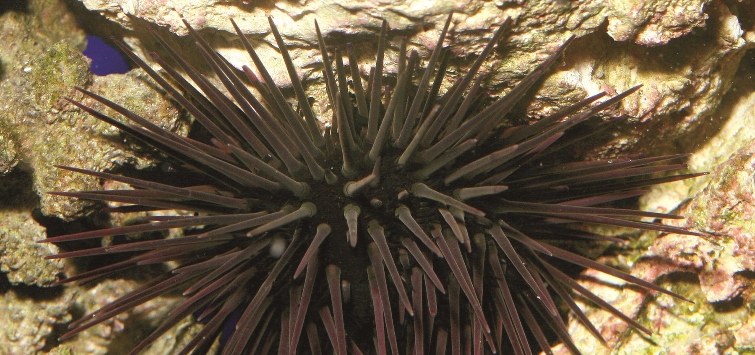
Small herbivorous urchins like this rock urchin can be great algae eaters, and they also make interesting-looking aquarium residents.
Next, there are the many unique-looking sea urchins. The most commonly offered tropical types are various rock urchins (Echinometra spp.), long-spined urchins (Diadema spp.), pencil urchins (Eucidaris spp.), and the very popular and colorful tuxedo urchin (Mespilia globulus), all of which can be kept safely in reef aquariums. In fact, I rarely see any others being offered in the hobby these days, and as best as I can tell, they all eat microalgae and filamentous algae.
Urchins do come in a range of sizes, with the commonly seen types having a body (properly called a test) that typically grows to no more than a couple of inches (5 cm) across. Every once in a while a larger species can be found, but I’d avoid those, as they can knock over and rearrange surprisingly heavy pieces of rock and such. Of course, the length of their spines is highly variable, too, but as long as you can avoid being stuck by them, it isn’t an issue.
When it comes to potential cons, the bulldozing is definitely one of them. Urchins use suction cup-tipped appendages to move around, which they do a lot, and in the process of getting from place to place, even small urchins can bowl over small corals and rocks that aren’t firmly attached to the substrate.
Unfortunately, they can scour nicely colored coralline algae off rocks, too, eating stuff that you might not want eaten. This is seen as thin, zig-zagging white trails across patches of colorful coralline, but it’ll typically grow right back. Other than that, while I’ve never owned an acrylic aquarium, I have heard reports that their grazing can leave those trails permanently on the relatively soft material, so urchins should probably be avoided if you have an acrylic tank.
Sea Stars
Now let’s take a look at some reef tank clean-up crew members that will go to work on a sandy substrate, starting with some sea stars that have eared themselves the name sand-sifter stars.
Sand-sifter stars can sometimes be found on top of a sandy substrate, but they usually stay buried just below the surface, where they root around in search of food. They will come out if they sense leftover fish food or something they can eat, but when they’re in the substrate, they eat small sand-dwelling invertebrates, stirring up and cleaning the sand in the process. They don’t actually eat algae or detritus, or at least not enough to survive off it, but they do stir some up, which can then be removed from the water using a mechanical filter.
There are a few very similar sand-sifter stars belonging to the genera Astropecten, Archaster, and Luidia that are quite common. They may reach several inches across, and their size increases the potential for starvation unless they’re kept in a large, well-stocked tank. Otherwise, they will eventually empty a sand bed of everything that they consider food and then starve to death, unless you keep them supplied with supplemental foods like sinking pellets.
Sea Cucumbers
There are several types of sea cucumber offered in the hobby. They earn their keep by mopping up and engulfing detritus, leftover fish food, and sand using highly branched tentacles. They digest bacteria and algae that coat grains of sand, too, and then release feces that are basically lumps of cleaned-up sand. These fall apart over time, and the sand is assimilated back into the substrate.
The detritus-eating types are commonly offered as tiger-tail cucumbers, but tiger-tails actually aren’t one species. Those sold as tiger-tails usually aren’t very particular about what they eat regardless of the actual species, though, so it may not really matter. Most of them are in the genus Holothuria, and the commonly offered species are Holothuria atra from the Indo-Pacific and H. impatiens or H. thomasi from the Caribbean.
Unfortunately, many species of cucumber get too large to keep in a typical reef aquarium, up to a foot or two (30 to 60 cm) or even more in length. However, most large species will starve to death long before growing that big. A general suggestion is to have no more than an inch (2.5 cm) of cucumber per square foot of exposed sand so they will have enough detritus to feed on.
Many can expel all of their guts or a dose of fish-killing toxin when stressed. Cucumbers have remarkable powers of regeneration and can recover from this under optimal conditions, as they can make all-new guts at a later time. However, this “cuke nuke,” as it’s often called, can make a real mess if ejected in an aquarium and should be cleaned up immediately. Any toxins will have to be dealt with using large water changes, strong skimming, and activated carbon.
Fortunately, this is uncommon with proper care, and it is also uncommon for the detritus-feeding cucumbers in general. It’s most often the result of a wandering cucumber getting stuck in a pump, so if you choose to have a cucumber, make sure that any intakes are covered by a screen.
Industrious Inverts
There are other cleaning critters out there, but the above are the most commonly offered ones in my experience. Always be mindful not to add too many of these animals to an aquarium, nor add specimens that are too large.
A good rule with reef tank clean-up crews, as with many things in life, is not to overdo it. In a textbook case of “too much of a good thing,” if you add too robust of an aquarium clean-up crew, they will tend to eat themselves out of a job—your tank eventually becomes simply too clean for them to stay alive and healthy.
See the full article on TFH Digital
https://www.tfhdigital.com/tfh/mar_apr_2019/MobilePagedReplica.action?pm=2&folio=72#pg75



